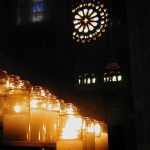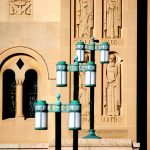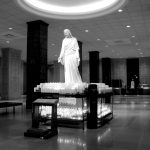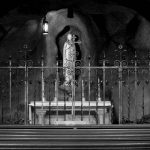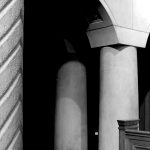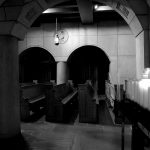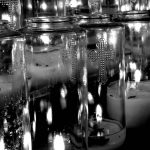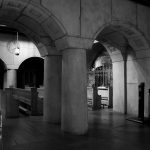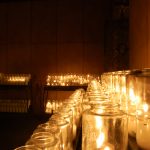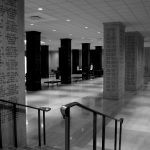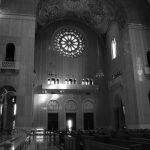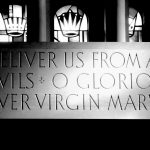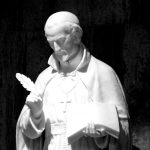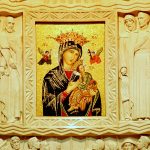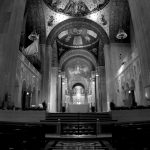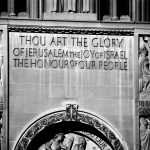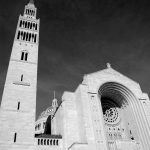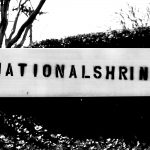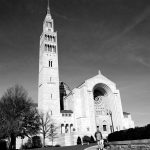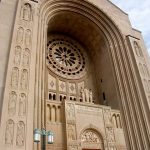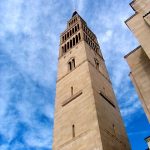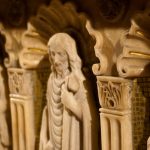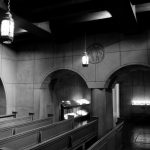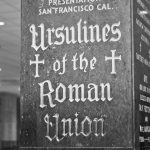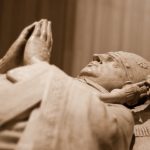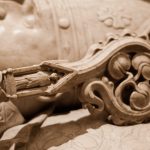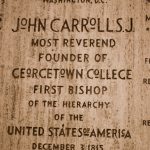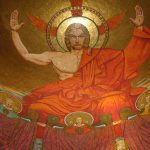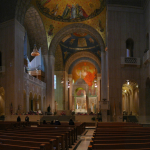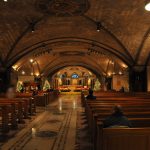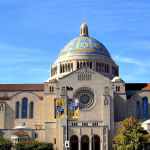
The first time I ever set foot inside the Basilica of the National Shrine of the Immaculate Conception in Washington, DC, I must have been about 15 years old. Having traveled through the night, we arrived in time for the morning Mass that would kick off the day’s events, culminating with the annual March for Life. As we walked through the inscription-laden walls of the crypt Church, commemorating the countless donors who had helped to construct the shrine, we picked our way past an ocean of sleeping bags, pilgrims stretched out on the hard marble floors trying to catch a few fleeting moments of sleep.

As a resident of a rural town in upstate New York just a short walk from the Pennsylvania border, I had never set foot in such an amazing Church structure. The sheer massivity of the building was awe-inspiring, and well it should have been – the National Shrine is the largest church in the United States, and the eighth largest in the entire world.
At the time, I had no idea what a staple the shrine would become in my life. I didn’t know how many times I would visit it as a Marcher, showing up there not only in high school but year after year with my friends in college; that I would later move to Northern Virginia and frequent the shrine’s confessionals (and their daily offering of the sacrament) in the company of a certain beautiful young woman; that I would kneel with that same beautiful young woman in front of the bejeweled tabernacle in the crypt church and present her with a gemstone of my own, asking her to be my wife, or that I would later visit with my own children, inspiring them with its incredible Romanesque-Byzantine architecture just as I was inspired in my youth. Its presence is a comfort, a constant in the backdrop of my life as an American Catholic.

The shrine is, of course, dedicated to the Immaculate Conception of Mary, which is itself a uniquely American devotion. Though Spain has the earliest claim to Our Lady’s conception, this in turn brought the devotion to American shores. In 1644, Pope Innocent X gave his permission for the feast of the Conception of the Blessed Virgin Mary to be a holy day of obligation in Spain and its possessions – which included Spanish colonies in the Americas. In 1761, Our Lady — under the title of the Immaculate Conception — was made Patroness of Spain (and those lands within her realm) by Pope Clement XIII, and permission was granted to these territories to make use of the office and Mass proper to this devotion.
In May of 1846, the Sixth Provincial Council of Baltimore got underway, under the leadership of Archbishop Samuel Eccleston. At the time, the ecclesiastical province of Baltimore covered the entire United States, so the meeting of 23 bishops there was concerned with issues facing the American Church as a whole. It was at this meeting when Our Lady of the Immaculate Conception was made patroness of our nation. In the June, 1964 issue of The American Ecclesiastical Review, the Franciscan writer and historian Father Marion Habig recounted the events that transpired:
On May 13 the bishops of the United States who were gathered in the residence of the Archbishop and under his chairmanship for the third private meeting of the Council, which began at nine in the morning, adopted a decree by which they chose the Blessed Virgin Mary, conceived without sin, as Patroness of the United States.
This decree, translated from the Latin into English, is as follows:
With enthusiastic acclaim and with unanimous approval and consent, the Fathers [of the Council] have chosen the Blessed Virgin Mary, conceived without sin, as the Patroness of the United States of America; without, however, adding the obligation of hearing Mass and abstaining from servile work on the feast of the Conception of Blessed Mary. And, therefore, they decided that the Supreme Pontiff be humbly asked to transfer the solemnity, unless the feast fall on a Sunday, to the nearest Sunday, on which both private and solemn Masses may be celebrated of the feast thus transferred, and the vesper office of the same feast may be recited.
Shea tells us that it was “to gratify a pious desire pervading the whole United States,” that “the Fathers of the Council petitioned the Sovereign Pontiff to ratify their choice of the Blessed Virgin Mary, conceived without sin, as Patroness of the United States, and to transfer the solemnization of the feast to the following Sunday.”1
In the fourth private meeting of the Council, held on May 15, same time and same place, the bishops of the United States agreed to ask the Holy See for permission, in all the dioceses of the country, to add the word “Immaculate” in the orations and preface of the divine office and Mass of the Conception of Mary; and also to add in the Litany of the Blessed Virgin the invocation: “Queen, conceived without sin, pray for us.”
[…]
The request of the American bishops for permission to add the word “Immaculate” in the orations and preface for the feast of the Conception of the Blessed Virgin requires some explanation. The feast of the Conception of Mary was celebrated in some places already in the thirteenth century; however, it did not clearly teach the Immaculate Conception. That was done in the Office “Sicut Lilium” and the Mass”Egredimini” of Leonard of Nogarolis, which was approved in 1477 by Sixtus IV; in fact, these had the same oration we have today for the feast of the Immaculate Conception. When Pius V revised the Roman Breviary in 1568, though the Franciscans were allowed to retain the Office and Mass of Nogarolis, this office was dropped for the rest of the Church and the office of the Nativity of the Blessed Virgin was substituted, the word “Conception” being substituted for “Nativity.”
When the American bishops asked for permission to add the word “Immaculate,” they anticipated and perhaps influenced a step taken by Pope Pius IX a year after he had granted the petition of the American bishops. On Sept. 30, 1847, this Pope authorized for the diocese of Rome a new office and Mass proper to the feast of the Immaculate Conception and clearly teaching the doctrine of Mary’s Immaculate Conception; and, two years later, he extended the new office and Mass to the universal Church.
On Dec. 8, 1854, eight years and four months after the American bishops had chosen Mary Immaculate as the Patroness of the United States, Pope Pius IX solemnly declared the Immaculate Conception of the Blessed Virgin Mary to be an article of faith.

It seems that the American Bishops were ahead of their time in recognition and honor of this Marian dogma. Father Habig notes that the devotion was not new in the United States, but it spread quickly in the years following the dedication of Our Lady’s patronage:
In 1846, therefore, when the bishops of the United States dedicated our land in a special manner to the Immaculate Conception, choosing the Blessed Virgin under this title as the special Patroness of our country, it was a re-dedication as far as that part was concerned which had once belonged to Spain-Our Spanish Borderlands, which were placed under the patronage of Mary Immaculate already in 1760.
In his History of Devotion to the Blessed Virgin Mary in North America, MacLeod tells us that in 1862, of more than eight hundred churches in North America which were dedicated to the Blessed Virgin, 145 were named for the Immaculate Conception. Another count made by Fr. Maynard Geiger, O.F.M., in 1943, shows that out of 4,817 churches and institutions in the United States dedicated to the Blessed Virgin Mary, 637 honor the Immaculate Conception.
Perhaps most significant among these was a church yet to be built at the time — the Basilica of the National Shrine of the Immaculate Conception in Washington, DC. The ideas for the church that would become the shrine seem to have taken shape around the same time as the American bishops were petitioning Rome for the patronage of Our Lady:
In 1846, an excerpt from a Massachusetts newspaper told of “a magnificent Catholic church [to] be built at Washington, D.C. after the manner of the great cathedrals of the Old World from subscriptions of every Catholic Parish in America.”
Spanning the late 19th, 20th and now 21st century, American Catholics would indeed build a sanctuary that rivals those of Europe and the world, not only in size but in stature as well—in sacred art, architecture, history and heritage.
It was Bishop Thomas Shahan, then rector of The Catholic University of America, who proposed the construction of the shrine and its dedication to Our Lady of the Immaculate Conception. He personally brought his petition to Pope St. Pius X in 1913. With the approval of and even a personal financial contribution from the saintly pope, Shahan returned to the United States and convinced the Catholic University Board of Trustees to donate some land from part of the University campus for the construction of the church. In January, 1914:
Shahan published the first issue of Salve Regina, a newsletter meant to stir enthusiasm for his project. He wrote that the shrine would be a “monument of love and gratitude, a great hymn in stone as perfect as the art of man can make it and as holy as the intentions of its builders could wish it to be.” His newsletter was circulated to dioceses throughout the country and financial donations began to pour into Washington. In 1915 Father Bernard McKenna of Philadelphia was appointed by Shahan as first director of the national shrine. Shahan oversaw the construction of the shrine until his death on March 9, 1932. His body is the only one interred at the national shrine.



The cornerstone of the shrine was laid in 1920, and six years later, the Crypt Church was completed, with the remainder of that level reaching completion in 1931. Unfortunately, the Great Depression and the subsequent beginning of World War II made it impossible for construction of the upper level to continue for over twenty years. At last, in 1954, construction resumed, with the Great Upper Church completed four years later. On November 20, 1959, the National Shrine was dedicated.

With its variety of chapels devoted to Our Lady as she has appeared in different cultures around the world, the National Shrine is not just an American basilica, but one with a truly international ethos. In fact, when Pope John Paul II became the first pope to visit the National Shrine of the Immaculate Conception, he said:
“This Shrine speaks to us with the voice of all America, with the voice of all the sons and daughters of America, who have come here from the various countries of the Old World. When they came, they brought with them in their hearts the same love for the Mother of God that was characteristic of their ancestors and of themselves in their native lands. These people, speaking different languages, coming from different backgrounds of history and traditions in their own countries, came together around the heart of a Mother they all had in common. While their faith in Christ made all of them aware of being one People of God, this awareness became all the more vivid through the presence of the Mother in the work of Christ and the Church.”
Similarly, on his visit in 2008, Pope Benedict XVI said:
“Dear Brother Bishops, it gives me great joy to greet you today at the start of my visit to this country…in this Basilica dedicated to the Immaculate Conception of the Blessed Virgin Mary, a shrine of special significance to American Catholics, right in the heart of your capital city. Gathered in prayer with Mary, Mother of Jesus, we lovingly commend to our heavenly Father the people of God in every part of the United States…I commend the Church in your country most particularly to the maternal care and intercession of Mary Immaculate, Patroness of the United States. May she who carried within her womb the hope of all nations intercede for the people of this country, so that all may be made new in Jesus Christ her Son. To all of you, and to your clergy, religious and lay faithful, I cordially impart my Apostolic Blessing as a pledge of joy and peace in the Risen Lord.”
The Basilica of the National Shrine of the Immaculate Conception is one of the great Catholic masterpieces in the Americas. It is fitting that it is named after the great patroness of our nation, Our Lady of the Immaculate Conception. I echo the words of Pope Benedict in prayer: “May she who carried within her womb the hope of all nations intercede for the people of this country, so that all may be made new in Jesus Christ her Son.”
ADDITIONAL IMAGES:
(All images by Steve Skojec unless otherwise attributed above)
Originally published on December 8, 2014.


